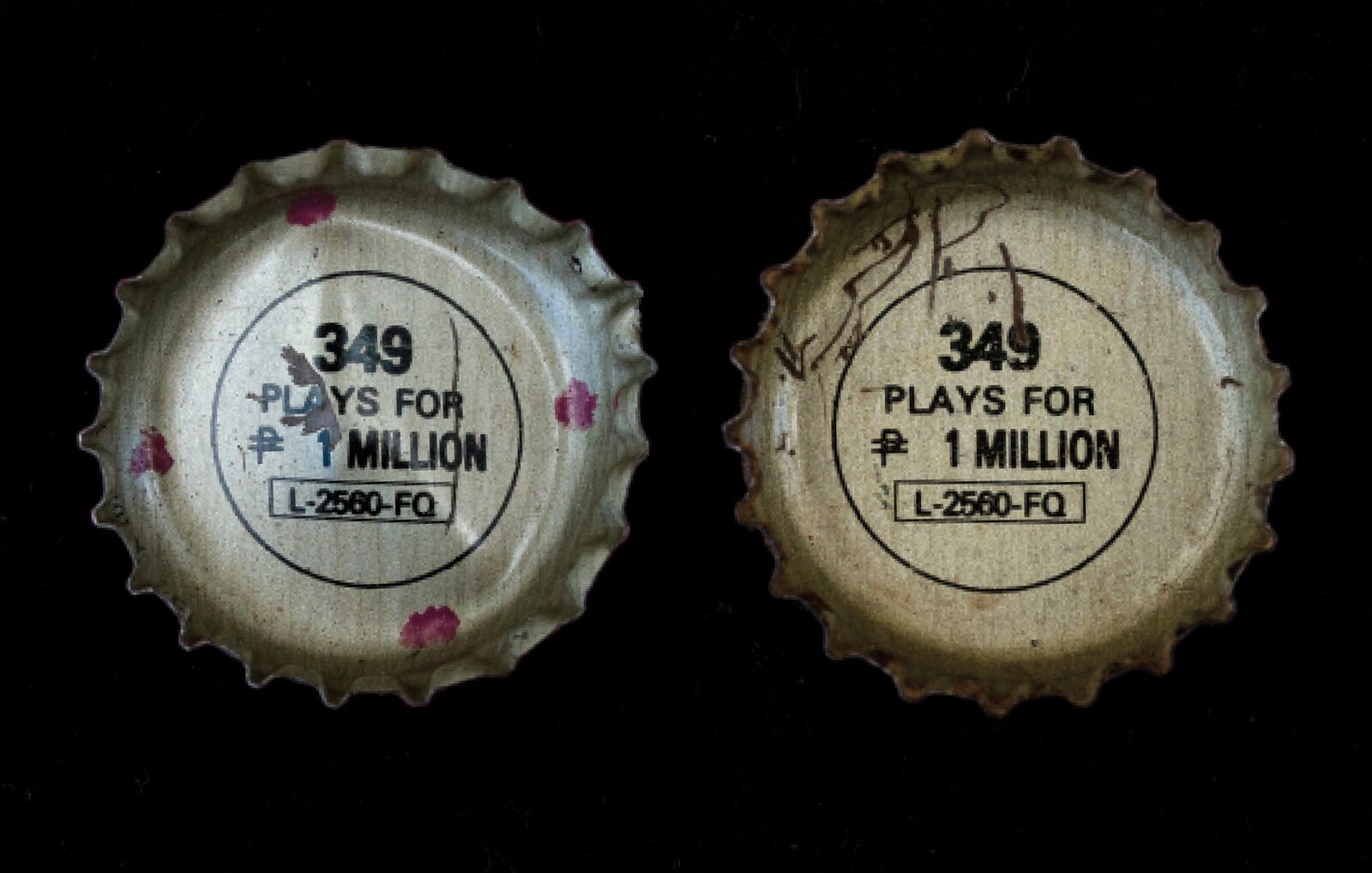On May 25, 1992, a tv programme on Channel a pair Philippines airy a section that had been running for three months. Each night, the station declared the winning numbers in Pepsi’s range Fever campaign. Shopping for a specially marked dope product allowed customers to match the quantity beneath the bottle cap to the announcements. Whereas most prizes were simply one hundred pesos, there was a chance to win the grand prize of 1 million pesos.
The Philippines was a rustic battling a modest economy and widespread poorness, which grand prize was perceived as a life-changing quantity of cash. thus once 349, that night's winning range, flashed on the screen that night, tens of thousands of Filipinos couldn’t believe their luck. the quantity was related to the most important prize within the sweepstakes. succeeding morning, dope plants in Manila were flooded with individuals toting their 349-emblazoned bottle caps and searching for a secure reward.
 |
| Two of Pepsi’s infamous 349 crowns. Photographer: Geric Cruz for Bloomberg Businessweek |
But, to their disappointment, There wasn’t one.
Pepsi had created an enormous error. solely 2 of the grand prizes were presupposed to be dealt out. Instead, dope had somehow factory-made 800,000 caps with the winning range of 349. The winners were turned away, and wire was erected around the plants. Riots, boycotts, and picketing ensued. home-baked bombs were launched at bottling factories. within the words of 1 dope government, “we had death threats for breakfast.”
The giveaway was supposed to spice up sales. Instead, dope executives weren't solely hurt market share—they were suddenly in concern for their lives.
So, however, did it happen?
To determine winning numbers, dope recruited D.G. Consultores, a promoting firm based mostly in a North American country. The numbers were generated via pc and so secured in an exceedingly safe strongbox in Manila. From there, the list would be wont to “seed” bottle caps within the bottling plants. Each night, the corporate would announce the day’s winning range on tv.
Somehow, that system went awry. A pc bug told bottlers to print 800,000 caps with the 349 designations, though all of them aside from 2 lacked a special security code that tested the cap was authentic. That detail was irrelevant to customers, WHO saw that they'd the quantity and proceeded to demand the prize they felt was owed to them.
Quickly, dope executives within the Philippines associate degreed stateside convened for an emergency meeting at three a.m. on a way to proceed. Economically, honouring the perceived worth of all of the caps was just about not possible to justify—it would’ve priced the corporate tens of billions of greenbacks. Instead, they opted to declare it an occurrence and offered $18 to $20 to cap holders as a “goodwill gesture.”
Whilst some accepted the prize, most customers were livid.
Pepsi delivery trucks became associate degree early and frequent casualties of the war on the potable manufacturer. Between thirty-two and thirty-seven trucks were turned, burned, stoned, or otherwise vandalized by protestors, several of whom took to the streets with signs and bullhorns to voice their chafe over the company's wrongdoing. company dope offices were targeted by Molotov cocktails and makeshift explosives that crashed into windows and front lawns. One home-baked bomb was supposed for a truck unbroken rolling and landed close to an instructor, killing her and a 5-year-old student and wounding six others.
Fretful dope executives employed bodyguards, armed passengers in delivery trucks, and forced expatriates from the country, exploit simply a handful—including one with expertise in Beirut—to face the angry mobs, that was quickly turning into organized. many spun off into factions, together with Coalition 349, that took a scientific approach to shame dope into paying up. once electing a pacesetter, Vicente del Fierro boy., they wrote anti-Pepsi tracts and concerned product boycotts.
Slowly, Pepsi’s black eye in Manila began to fade. Most of the civil suits and criminal complaints were tossed out of court. Sensing that the corporate had additional determination to stay within the country than protestors had the time or energy to continue marching, the anti-Pepsi sentiment began to dim. By 1994, their market share had rebounded from a coffee of seventeen per cent post-scandal to twenty-one per cent.
In 2006, a Philippines Supreme Court ruling closed the book on the outstanding charge and potential liability, finding that dope wasn't indebted to honour the sweepstakes payout because of the error. it absolutely was a protracted if satisfactory, conclusion to the difference.